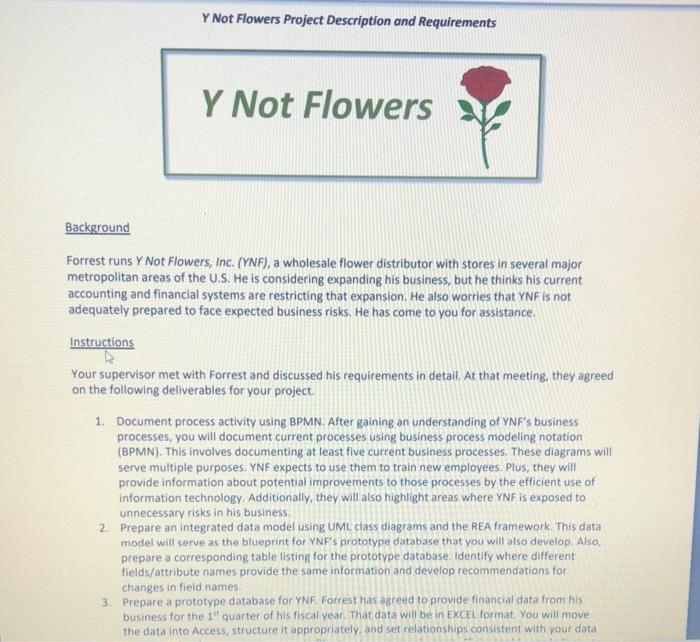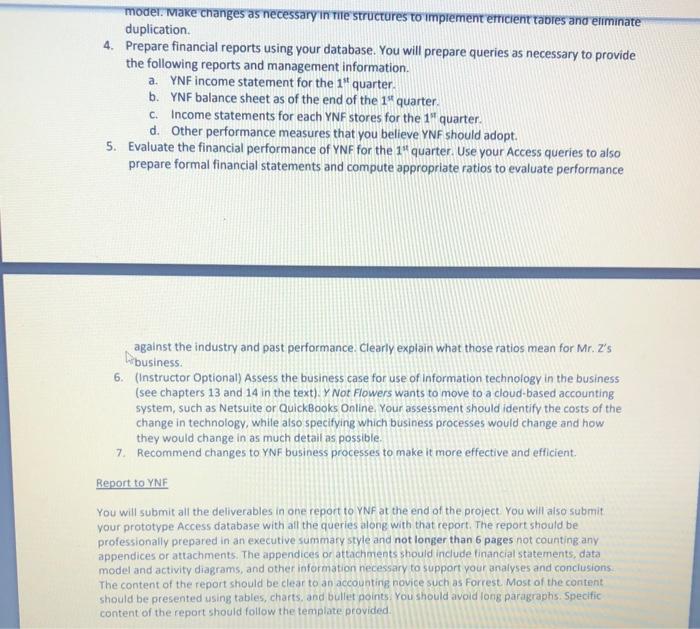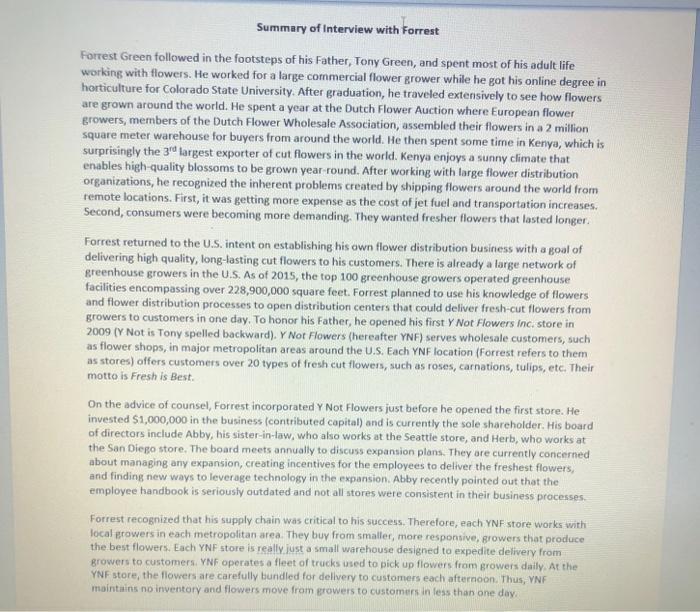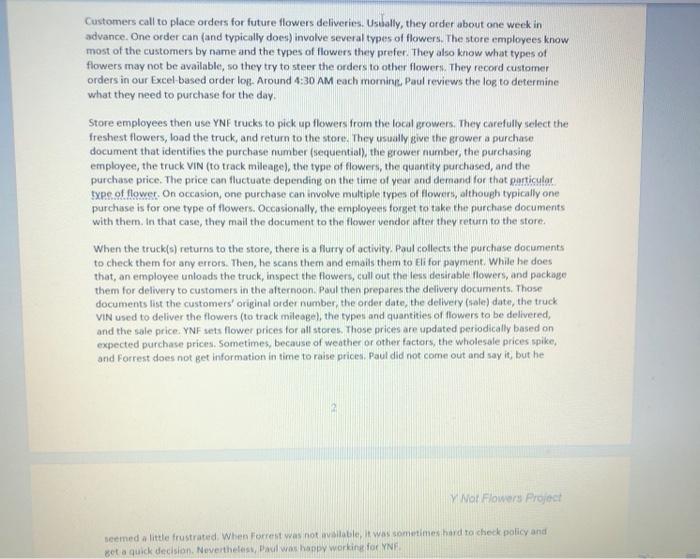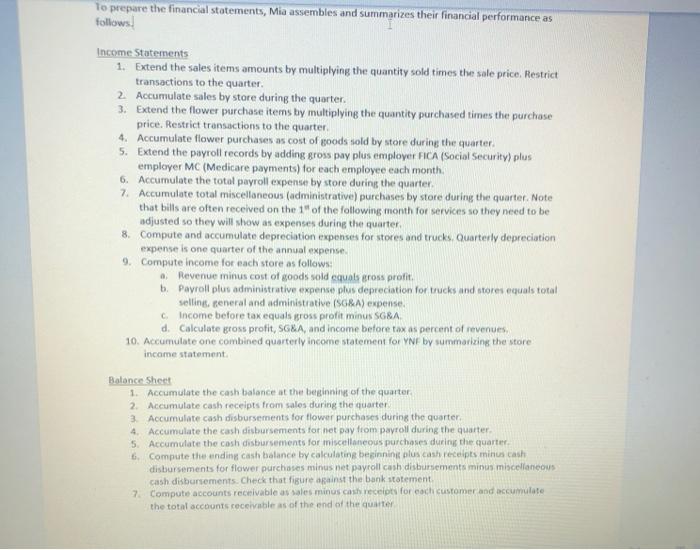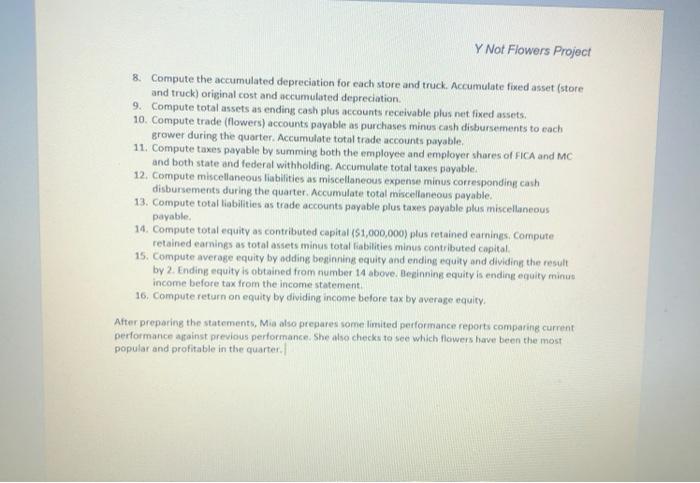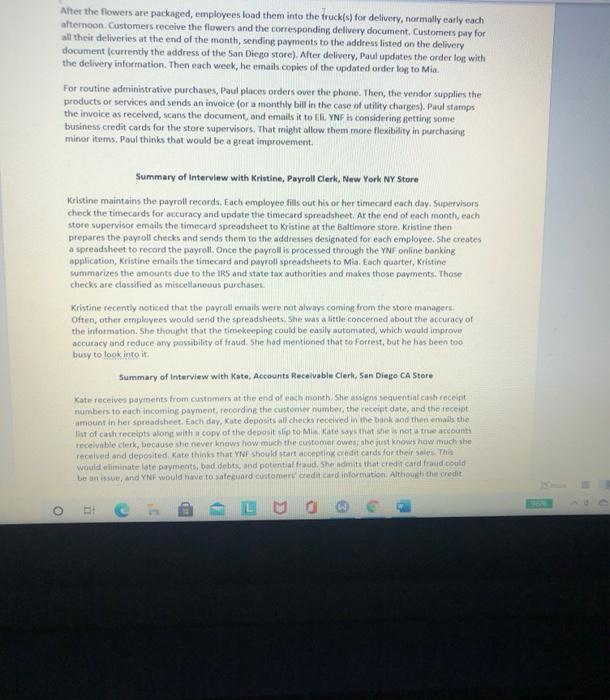Y Not Flowers Project Description and Requirements Y Not Flowers Background Forrest runs Y Not Flowers, Inc. (YNF), a wholesale flower distributor with stores in several major metropolitan areas of the U.S. He is considering expanding his business, but he thinks his current accounting and financial systems are restricting that expansion. He also worries that YNF is not adequately prepared to face expected business risks. He has come to you for assistance Instructions Your supervisor met with Forrest and discussed his requirements in detail. At that meeting, they agreed on the following deliverables for your project 1. Document process activity using BPMN. After gaining an understanding of YNF's business processes, you will document current processes using business process modeling notation (BPMN). This involves documenting at least five current business processes. These diagrams will serve multiple purposes. YNF expects to use them to train new employees. Plus, they will provide information about potential improvements to those processes by the efficient use of information technology. Additionally, they will also highlight areas where YNF is exposed to unnecessary risks in his business 2. Prepare an integrated data model using UML class diagrams and the REA framework. This data model will serve as the blueprint for YNF's prototype database that you will also develop. Also, prepare a corresponding table listing for the prototype database. Identify where different fields/attribute names provide the same information and develop recommendations for changes in field names 3. Prepare a prototype database for YNF Forrest has agreed to provide financial data from his business for the 1" quarter of his fiscal year. That data will be in EXCEL format. You will move the data into Access, structure it appropriately and set relationships consistent with your data modermake changes as necessary in Tile structures to implement emricient tables and eminare duplication 4. Prepare financial reports using your database. You will prepare queries as necessary to provide the following reports and management information. a. YNF income statement for the 1" quarter. b. YNF balance sheet as of the end of the 15 quarter. C. Income statements for each YNF stores for the 1" quarter. d. Other performance measures that you believe YNF should adopt. 5. Evaluate the financial performance of YNF for the 1" quarter. Use your Access queries to also prepare formal financial statements and compute appropriate ratios to evaluate performance against the industry and past performance. Clearly explain what those ratios mean for Mr.Z's business. 6. (Instructor Optional) Assess the business case for use of Information technology in the business (see chapters 13 and 14 in the text). Y Not Flowers wants to move to a cloud-based accounting system, such as Netsuite or QuickBooks Online. Your assessment should identify the costs of the change in technology, while also specifying which business processes would change and how they would change in as much detail as possible. 7. Recommend changes to YNF business processes to make it more effective and efficient Report to YNF You will submit all the deliverables in one report to YNF at the end of the project. You will also submit your prototype Access database with all the queries along with that report. The report should be professionally prepared in an executive summary style and not longer than 6 pages not counting any appendices or attachments. The appendices or attachments should include financial statements, data model and activity diagrams, and other information necessary to support your analyses and conclusions The content of the report should be clear to an accounting novice such as Forrest. Most of the content should be presented using tables, charts, and bullet points: You should avoid long paragraphs. Specific content of the report should follow the template provided Summary of Interview with Forrest Forrest Green followed in the footsteps of his father, Tony Green, and spent most of his adult life working with flowers. He worked for a large commercial flower grower while he got his online degree in horticulture for Colorado State University. After graduation, he traveled extensively to see how flowers are grown around the world. He spent a year at the Dutch Flower Auction where European flower growers, members of the Dutch Flower Wholesale Association, assembled their flowers in a 2 million square meter warehouse for buyers from around the world. He then spent some time in Kenya, which is surprisingly the 3rd largest exporter of cut flowers in the world. Kenya enjoys a sunny climate that enables high-quality blossoms to be grown year-round. After working with large flower distribution organizations, he recognized the inherent problems created by shipping flowers around the world from remote locations. First, it was getting more expense as the cost of jet fuel and transportation increases. Second, consumers were becoming more demanding. They wanted fresher flowers that tasted longer Forrest returned to the U.S. intent on establishing his own flower distribution business with a goal of delivering high quality, long-lasting cut flowers to his customers. There is already a large network of greenhouse growers in the U.S. As of 2015, the top 100 greenhouse growers operated greenhouse facilities encompassing over 228,900,000 square feet. Forrest planned to use his knowledge of flowers and flower distribution processes to open distribution centers that could deliver fresh-cut flowers from growers to customers in one day. To honor his father, he opened his first Y Not Flowers inc. store in 2009 (Y Not is Tony spelled backward). Y Not Flowers (hereafter YNF) serves wholesale customers, such as flower shops, in major metropolitan areas around the U.S. Each YNF location (Forrest refers to them as stores) offers customers over 20 types of fresh cut flowers, such as roses, carnations, tulips, etc. Their motto is Fresh is Best On the advice of counsel, Forrest incorporated Y Not Flowers just before he opened the first store. He invested $1,000,000 in the business contributed capital) and is currently the sole shareholder. His board of directors include Abby, his sister-in-law, who also works at the Seattle store, and Herb, who works at the San Diego store. The board meets annually to discuss expansion plans. They are currently concerned about managing any expansion, creating incentives for the employees to deliver the freshest flowers, and finding new ways to leverage technology in the expansion Abby recently pointed out that the employee handbook is seriously outdated and not all stores were consistent in their business processes. Forrest recognized that his supply chain was critical to his success. Therefore, each YNF store works with local growers in each metropolitan area. They buy from smaller, more responsive, growers that produce the best flowers. Each YNF store is really just a small warehouse designed to expedite delivery from growers to customers. YNF operates a fleet of trucks used to pick up flowers from growers daily. At the YNF store, the flowers are carefully bundled for delivery to customers each afternoon. Thus, NF maintains no inventory and flowers move from growers to customers in less than one day, Most recordkeeping takes place locally. Each store keeps track of its purchases, inventories, sales, etc. The only centralized functions were writing checks, receiving payments from customers, and processing payroll. The stores regularly email records to Mia and then forward hard copy documents each month, so she can monitor operations and provide updates to Forrest. Since, Forrest plans to continue expanding YNF, he wants to improve his accounting systems. He believes that eventually he should use an online accounting system (doud computing) and have each store submit transactions daily via the internet from various smart devices, such as smartphones and tables. First, he wants a thorough evaluation of the costs and benefits of this change. Y Not Flowers Project Summary of Interview with Ell, AP Clerk, Philadelphia PA Store El prepares checks for payments to growers and other vendors. The stores email purchase documents to Eli each week and at the end of the month). He pays all vendors at the end of the month for purchases during the month. If there are multiple purchases from the same grower or other vendor during the month, Ell writes one check for all the purchases. After processing the payments through YNE's online banking application, Eli updates his AP spreadsheet and emails the cash disbursement records to Mia, the accounting clerk Eli is a little worried, though. He has no ability to verify that the checks are going to valid vendors. He just pays the vendor listed on the purchase documents. He felt that YNF should have an approved vendor list. Additionally, he wanted Forrest to consider using a company credit card for most purchases. It would reduce the workload errors, and delays involved with emailing documents between stores, Summary of Interview with Paul, Supervisor, Portland OR Store Paul is the supervisor for the Portland store, and his duties are similar to supervisor duties at all the stores. Being supervisor is only a part-time responsibility. Most of the time, Paul is just another employee at the Portland store, buying flowers, preparing flowers for delivery to customers, making deliveries, etc Summary of Interview with Kate, Accounts Receivable Clerk, San Diego CA Store Kate receives payments from customers at the end of each month. She assignes sequential cash receipt numbers to each incoming payment, recording the customer number, the receipt date, and the receipt amount in her spreadsheet. Each day, Kate deposits all checks received in the bank and then mail the list of cash receipts along with a copy of the deposit ship to Mia. Kate says that she is not true accounts receivable cerk, because she never knows how much the customer wes she just knows how much she received and deposited. Kate thinks that YNF should start accepting credit cards for their sales. This would eliminate late payments, bad debts, and potential fraud. She admits that credit card fraud could be an issue, and YNF would have to safeguard customers' credit card information. Although the credit card companies charge a fee, YNF could have almost instant access to the cash and the related sales information Y Not Flowers Project Summary of interview with Mia, Accounting Clarke Austin TX Store Mia ha cecently taken over the accounting duties for the lost. Shehu degree in accounting, but she received that de verano it was her job to the documents from Forrest and prepare the financement achter how rapidly that they stile close the statement Mihope that on they would To prepare the financial statement, Mimes and the cartomance follow O To prepare the financial statements, Mia assembles and summarizes their financial performance as follows Income Statements 1. Extend the sales items amounts by multiplying the quantity sold times the sale price. Restrict transactions to the quarter. 2 Accumulate sales by store during the quarter. 3. Extend the flower purchase items by multiplying the quantity purchased times the purchase price, Restrict transactions to the quarter. 4. Accumulate flower purchases as cost of goods sold by store during the quarter. 5. Extend the payroll records by adding gross pay plus employer FICA (Social Security) plus employer MC (Medicare payments) for each employee each month 6. Accumulate the total payroll expense by store during the quarter. 7. Accumulate total miscellaneous (administrative) purchases by store during the quarter. Note that bills are often received on the 1" of the following month for services so they need to be adjusted so they will show as expenses during the quarter 8. Compute and accumulate depreciation expenses for stores and trucks Quarterly depreciation expense is one quarter of the annual expense, 9. Compute income for each store as follows: Revenue minus cost of goods sold equals gross profit b. Payroll plus administrative expense plus depreciation for trucks and stores equals total selline, general and administrative (GBA) expense Income before tax equals gross profit minus SGRA d. Calculate gross profit, SG&A, and income before tax as percent of revenues, 10. Accumulate one combined quarterly income statement for NF by summarizing the store income statement Balance Sheet 1. Accumulate the cash balance at the beginning of the quarter 2. Accumulate cash receipts from sales during the quarter 3. Accumulate cash disbursements for flower purchases during the quarter 4. Accumulate the cash disbursements for not pay from payroll during the quarter 5. Accumulate the cash disbursements for miscellaneous purchases during the quarter 1. Compute the ending cash balance by calculating beginning olus cash receipts minus cash disbursements for flower purchases minus net payroll cash disbursements minus miscellaneous cash disbursements. Check that figure against the bank statement 7 Compute accounts receivable as sales minus cash receipts for each customer and accumulate the total accounts receivable as of the end of the quarter Y Not Flowers Project & Compute the accumulated depreciation for each store and truck. Accumulate fixed asset store and truck) original cost and accumulated depreciation. 9. Compute total assets as ending cash plus accounts receivable plus net fixed assets 10. Compute trade (flowers) accounts payable as purchases minus cash disbursements to each grower during the quarter. Accumulate total trade accounts payable 11. Compute taxes payable by summing both the employee and employer shares of FICA and MC and both state and federal withholding. Accumulate total taxes payable 12. Compute miscellaneous liabilities as miscellaneous expense minus corresponding cash disbursements during the quarter. Accumulate total miscellaneous payable. 13. Compute total liabilities as trade accounts payable plus taxes payable plus miscellaneous payable 14. Compute total equity as contributed capital (1,000,000) plus retained earnings. Compute retained earnings as total assets minus total fiabilities minus contributed capital 15. Compute average equity by adding beginning equity and ending equity and dividing the result by 2. Ending equity is obtained from number 14 above. Beginning equity is ending equity minus income before tax from the income statement, 16. Compute return on equity by dividing income before tax by average equity. After preparing the statements, Mia also prepares some limited performance reports comparing current performance painst previous performance. She also check to see which flowers have been the most popular and profitable in the quarter. After the flowers are packaged, employees load them into the truck(s) for delivery, normally early each afternoon. Customers receive the flowers and the corresponding delivery document. Customers pay for all their deliveries at the end of the month, sending payments to the address listed on the delivery document (currently the address of the San Diego store). After delivery, Poul updates the order to with the delivery information. Then each week, he email copies of the updated order log to Mia For routine administrative purchases, Paul places orders over the phone. Then, the vendor suppliers the products or services and sends an invoice for a monthly bill in the case of utility charges). Paul stamps the invoice as received, scans the document, and emails it to Eli. YNF is considering getting some business credit cards for the store supervisors. That might allow them more flexibility in purchasing minor items. Paul thinks that would be a great improvement Summary of Interview with Kristine, Payroll Clerk, New York NY Store Kristine maintains the payroll records. Each employee fills out his or her timecard each day. Supervisors check the timecards for accuracy and update the timecard spreadsheet. At the end of each month, each store supervisor emails the timecard spreadsheet to Kristine at the Baltimore store, Kristine then prepares the payroll checks and sends them to the addresses designated for each employee. She creates a spreadsheet to record the payroll. Once the payroll is processed through the YNF online banking application, Kristine emails the timecard and payroll spreadsheets to Mia. Each quarter, Kristine summarizes the amounts due to the IRS and state tax authorities and makes those payments. Those checks are classified as miscellaneous purchase Kristine recently noticed that the payroll emails were not always coming from the store managers Often, other employees would send the spreadsheets. She was a little concerned about the accuracy of the information. She thought that the timekeeping could be easily automated, which would improve accuracy and reduce any possibility of fraud. She had mentioned that to Forrest, but he has been too busy to look into it Summary of interview with Kate, Accounts Receivable Clerk, San Diego CA Store Kater receives payments from customers at the end of each month. She is sequential cash receipt numbers to each incoming payment recording the customer number the receipt date, and the receipt amount in her spreadsheet. Each day, Kate deposits all checks received in the bank and then email the Ist of cash receipts along with a copy of the deposit slip to MA Rote says that she is not a tree account receivable clerk, because she never knows how much the customer owes she just know how much she received and deposited, Kate thinks that YNF should start comptink credit cards for their sales. This would eliminate late payments, bad debts, and potential fraud. She admits that credit card fraud could be an issue and YNF would have to safeguard customer credit card information. Although the credit o MO
